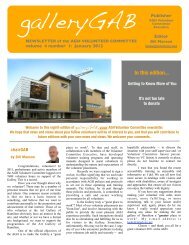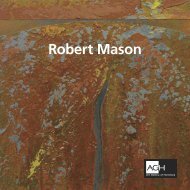WELCOME TO THE ART GALLERY OF HAMILTON
WELCOME TO THE ART GALLERY OF HAMILTON
WELCOME TO THE ART GALLERY OF HAMILTON
You also want an ePaper? Increase the reach of your titles
YUMPU automatically turns print PDFs into web optimized ePapers that Google loves.
- Furniture risers for tables<br />
- Alternate information for inaccessible spaces.<br />
• Designated staff in Education, Event services, Visitor Services and Security, are trained in the safety and<br />
use of wheelchairs.<br />
Communicating with a Visitor with a Disability<br />
Policy:<br />
The AGH’s policies and procedures take a person’s disability into account when communicating with the<br />
individual. Two-way communication is a process of providing, sending, receiving and understanding<br />
information. To communicate in an effective way, the AGH considers how the disability affects the way that<br />
the person expresses, receives or processes communications. Where possible, the AGH asks the visitor<br />
directly the best way to communicate with him/her.<br />
Procedures:<br />
The AGH uses a variety of ways, wherever possible, to make communications more accessible by:<br />
• Considering the needs of people with disabilities during the planning stage of services and communication<br />
development.<br />
• Using plain language to make a document easier to read for people with certain learning disabilities.<br />
• Offering information in alternate formats:<br />
- Hand-write or type information back and forth;<br />
- Large print maps;<br />
- Printed hand-outs of commonly used information;<br />
- Large print of commonly used information for people who have low vision;<br />
- E-mail as an alternate channel to provide accessible communication.<br />
Service Animals<br />
Policy:<br />
The AGH is committed to welcoming visitors with disabilities who are accompanied by a trained, accredited<br />
service animal. A service animal may accompany a visitor or any third party with a disability to all parts of<br />
our premises that are open to the public. Service animals may be used for, but not limited to, the following<br />
disabilities: vision loss, physical disability, hearing loss, autism, epilepsy etc. Although service animals are<br />
most commonly dogs, other service animals could include, but are not limited to, ferrets, monkeys etc. The<br />
AGH ensures that all employees, volunteers, interns, third parties and others dealing with the public are<br />
properly trained in how to interact with people with disabilities, who are accompanied by a service animal.<br />
Procedures:<br />
To be considered a service animal under this standard, it must either be readily apparent that the animal is<br />
being used because of a person’s disability or the person with a disability may be asked to provide a letter<br />
from a physician or nurse confirming that it is required because of his or her disability. The AGH does<br />
enforce a general by-law that does not permit pets on the premises, including the AGH property surrounding<br />
the building. Service animals are not pets - they are working animals. They are used by people with<br />
disabilities to overcome barriers much like assistive devices such as a white cane or a wheelchair.<br />
At times, due to capacity, visitors with disabilities accompanied by service animals may be advised that the<br />
crowded conditions may make it difficult to manoeuvre.<br />
Guide dogs or other service animals, including service animals in training, are allowed to accompany people<br />
with disabilities on the AGH premises open to the public.
















